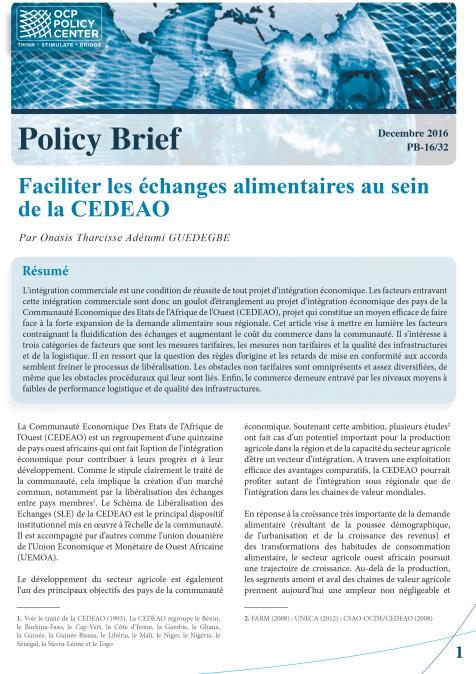RELATED CONTENT
-
AuthorsTaoufik AbbadJuly 5, 2017The continuous and reinforced process of accumulating physical capital, in which Morocco has embarked since the early 2000s, has helped to preserve the stability of the fundamental equilibrium and cushion the economy from various external and exogenous shocks. However, these accumulation efforts have not led to a significant increase in productivity gains or to an accelerated transformation of the productive base. This Policy Brief aims to describe the underpinnings of the capital a ...
-
AuthorsTaoufik AbbadJuly 5, 2017Le processus continu et renforcé de l’accumulation du capital physique, dans lequel s’est engagé le Maroc depuis le début des années 2000, a permis de préserver la stabilité des équilibres fondamentaux et d’amortir les différents chocs exogènes, aussi bien internes qu’externes. Cependant, cet effort d’accumulation n’a pas permis d’insuffler un accroissement significatif des gains de productivité et d’accélérer la transformation de la base productive. Ce Policy Brief propose de décri ...
-
Moubarack LoJune 21, 2017Ce podcast est présenté par Moubarack Lo. Il y analyse l’apport de l’adhésion marocaine à la CEDEAO suite à l’accord de principe donné par ses membres au 51e sommet de Monrovia le 4 juin ...
-
 AuthorsFernanda De NegriJune 20, 2017Brazil’s labor and total-factor productivity (TFP) have featured anemic increases in the last decades (Canuto, 2016). As we illustrate here, contrary to common view, sector structures of the Brazilian GDP and employment cannot be singled out as major determinants of productivity performance. Horizontal, cross-sector factors hampering productivity increases seem to carry more weight. Brazil’s productivity performance has been dismal Since the end of the 1970s, the Brazilian labor p ...
AuthorsFernanda De NegriJune 20, 2017Brazil’s labor and total-factor productivity (TFP) have featured anemic increases in the last decades (Canuto, 2016). As we illustrate here, contrary to common view, sector structures of the Brazilian GDP and employment cannot be singled out as major determinants of productivity performance. Horizontal, cross-sector factors hampering productivity increases seem to carry more weight. Brazil’s productivity performance has been dismal Since the end of the 1970s, the Brazilian labor p ... -
AuthorsEliot PenceMay 19, 2017U.S. Africa policy has tended to shift over time and has lacked a clear overarching strategic vision. The Trump administration’s approach in Africa should articulate a limited set of principles that clarifies and solidifies a more sustainable framework that is better suited to address fundamental drivers of Africa’s future. These principles include prioritizing key countries and rationalizing resources, creating an “Investment- First” policy in Africa, and more clearly communicating ...
-
Marcus Vinicius de FreitasApril 27, 2017This podcast is performed by Mr. Marcus Vinicius de Freitas. The purpose of this Podcast is to discuss how to deal with decreasing government funds for public housing through Public-Priva ...
-
Otaviano CanutoApril 24, 2017This podcast is performed by Mr. Otaviano Canuto. Central banks of large advanced and many emerging market economies have recently gone through a period of extraordinary expansion of bala ...
-
AuthorsOnasis Tharcisse A. GuedegbeDecember 23, 2016L'intégration commerciale est une condition de réussite de tout projet d’intégration économique. Les facteurs entravant cette intégration commerciale sont donc un goulot d’étranglement au projet d’intégration économique des pays de la Communauté Economique des Etats de l’Afrique de l’Ouest (CEDEAO), projet qui constitue un moyen efficace de faire face à la forte expansion de la demande alimentaire sous régionale. Cet article vise à mettre en lumière les facteurs contraignant la flui ...
-
AuthorsOctober 13, 2016We develop an interregional computable general equilibrium model to help assess the ex ante impact of transportation infrastructure policies in Egypt. The model is integrated with a GIS network. We illustrate the analytical capabilities of the model by looking at the domestic integration of the country. Improvements of transportation costs among Egyptian governorates and of their links to the broader world economy are considered in stylized simulations. The results provide quantitat ...
-
AuthorsKarim EL MokriOctober 13, 2016Le Maroc est actuellement plus que jamais menacé par le piège des économies à revenu intermédiaire. Il se retrouve pris entre, d'une part, la concurrence accrue exercée par des pays à faible revenu sur les secteurs à faible productivité et intensifs en main d'œuvre et, d'autre part, la difficulté d'accélérer son rythme de transformation structurelle vers des activités à plus forte valeur ajoutée et à contenu technologique plus élevé. L'expérience internationale nous montre que rares ...








